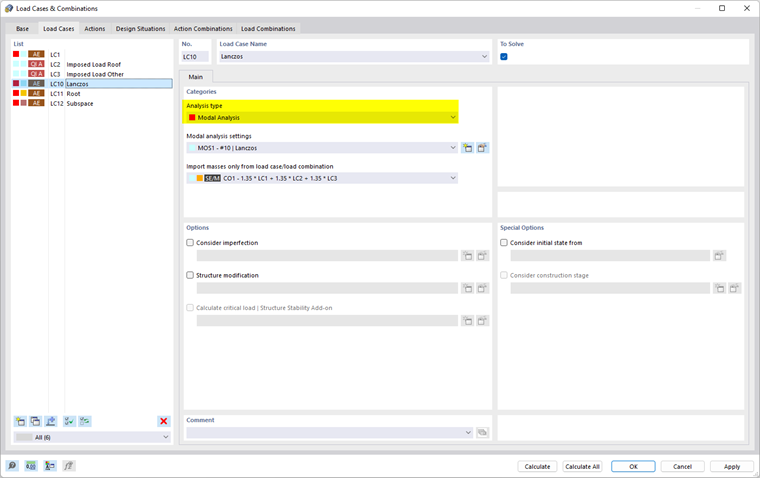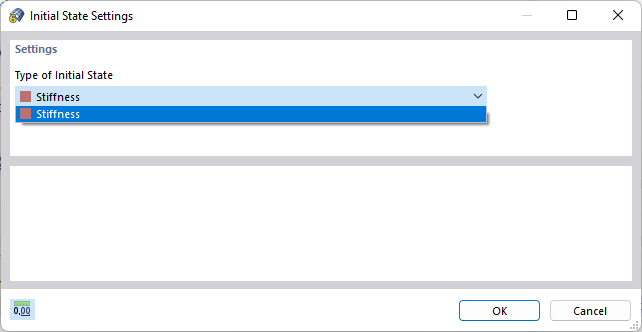The modal analysis is based on a load case to which a modal analysis type is assigned. It is possible to use several modal analysis load cases for the model.
In the Load Cases tab of the "Load Cases and Combinations" dialog box, you can assign the analysis types and define additional parameters. To do this, select the load case in the "list" on the left.
Categories
This section covers basic settings for a dynamic analysis of the load case.
Analysis Type
Once you have activated the "Modal Analysis" add-on in the model's Base Data, the "Modal Analysis" is available in the list. Assign this analysis type to each load case for which you want to perform the dynamic analysis.
Modal Analysis Settings
In the list of "Modal Analysis Settings" (MOS), select the specifications used for the analysis of the load case. These are the eigenvalue method, mass matrix setting, or mass conversion, for example. These parameters are described in the chapter Modal Analysis Settings.
Use the
![]() button to add new modal analysis settings and the
button to add new modal analysis settings and the
![]() button to edit the existing modal analysis settings.
button to edit the existing modal analysis settings.
Import Masses only from Load Case / Combination
In the list of the defined load cases and combinations, specify which loading is to be considered as a mass in the modal analysis. The image Importing Masses from Load Case shows how to apply the load of the "Self-Weight" load case for a dynamic load case.
Self-Weight
This section is only visible if you want to consider the masses directly from the same modal analysis load case (see the image Load Case of Type "Modal Analysis" for Direct Load Transfer ). The effect is similar to the function, as described in the Self-Weight section of the RFEM manual for a structural analysis load case.
Options
If you activate the "Consider imperfection" check box, you can select an imperfection case from the list that should be used together with the load case in the modal analysis. The functions of an imperfection case are described in the chapters Considering Imperfection and Imperfection Cases of the RFEM manual. Use the
![]() button to create a new imperfection case.
button to create a new imperfection case.
The "Structure modification" check box enables the option to consider a stiffness adjustment or a special treatment of nonlinearities in the load case. These functions are described in the chapter Structure Modification. Select the structural modification from the list or create a new modification type using the
![]() button.
button.
Special Options
If you activate the "Consider initial state from" check box, you can select a load case from the list whose stiffnesses represent the initial position for the modal analysis of the selected load case.
The
![]() button next to the list opens the "Initial State Settings" dialog box. Define the "Type of Initial State" that is available. Only the "Stiffness" type is currently available.
button next to the list opens the "Initial State Settings" dialog box. Define the "Type of Initial State" that is available. Only the "Stiffness" type is currently available.
In the chapter Considering Initial State, you can find further explanations as well as an example of how the failed elements affect the modal analysis.

